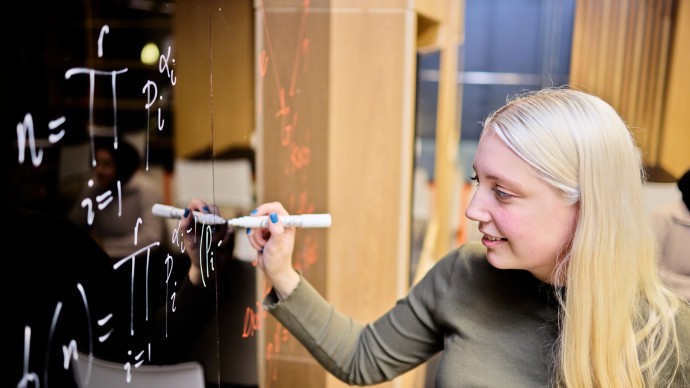Authentic assessment
What is authentic assessment?
‘Authentic assessment’ refers to the assessment of learning that is conducted through ‘real world’ tasks requiring students to demonstrate their knowledge and skills in meaningful contexts’ (Swaffield, 2011). Authentic assessments are designed to measure a learner’s ability to apply learning to real-world contexts.
What does an authentic assessment involve?
To produce what is considered authentic assessment, colleagues may base their assessment design on real-world contexts or professional standards. This approach has become a common feature of authentic assessment in Higher Education (HE), often related to employability.
However, recent work from McArthur (2023) urges us to pay closer attention to the social value of authentic assessment for broader applicability, which is enabled through a richer understanding of authenticity. To do this, McArthur suggests we should further consider why the task matters and indicates that doing this will promote “a shift from the student in isolation to the student as a member of society. Senses of achievement can become richer, thus enhancing the students’ sense of self, self-worth, and well-being.” (McArthur, 2023:85). Furthermore: “When we assess student learning we must focus on what it is we want students to achieve and avoid being driven too much by what is ‘easy to assess’ or how assessment has always been done in the subject. The content and methods of assessment should emphasise authenticity and complexity rather than reproduction of knowledge and reductive measurement” (Sambell et al., 2012:6).
What does this mean for assessment design on my programme/unit?
McArthur (2023: 92) emphasises the need for authentic assessment to “fulfil its role shaping how, what, and why our graduates gain the education that they will take forward into a range of social roles”. With this in mind, when planning an authentic assessment, you may consider opportunities for developing applicable knowledge and skills in designing meaningful assessment tasks. An authentic assessment draws upon many of the features of Active Learning; therefore, our resources on resources on active learning might be a useful starting point for assessment design.
-
What should your assessment include?
- Clear links to the module learning outcomes.
- A clear and transparent marking process.
- An accessible and understandable assessment brief.
- A consideration of Active Learning approaches.
Assessment design may adopt an ‘authentic’ approach by incorporating elements of real-world contexts, professional standards, reflections on practice and other personalised and bespoke content, for example:
- Using activities related to real-world tasks or scenarios.
- Providing an opportunity for collaboration and co-production.
- Encouraging opportunities for reflection on lived experiences.
- Adopting problem-solving techniques and activities.
-
Assessment types
Below is a list of assessment types, many of which can be adapted to include authentic elements. Remember that authentic assessments use various methods to evaluate different types of learning and can be adapted to both formative and summative contexts.
- Poster.
- Debate.
- Policy papers, legal briefs.
- Exhibitions.
- Performance.
- Event organisation.
- Written reports.
- Reflective writing, personal ethnographies, portfolio assessments.
- Pitching an idea, invention, or project.
- Vivas or one-to-one dialogues.
- Blogging, podcasting, and producing documentary films.
It is essential to review your approaches to authentic assessment regularly, which requires careful thought and implementation and a capacity to be flexible/adaptable. We would therefore encourage discussions amongst programme teams to establish a shared understanding of authentic assessment.
Authentic assessment and artificial intelligence

Artificial Intelligence (AI) is technology that will transform the workplace, and as such we need to make sure that our students are best placed to take advantage of it as a tool to support their learning and when they move into employment.
Towards the end of 2022, there was a lot of interest in Higher Education about the use of AI tools like ChatGPT being used by students for assessments. This guidance is in response to that and seeks to identify the opportunities of AI as well as indicating what can be done by academics who have concerns about their assessments.
By adopting authentic assessment, AI platforms such as ChatGPT become less amenable to creating material that can be passed off as students’ work for assessment purposes. These systems use language models and cannot think, feel or know how and why. As a result, they may struggle to produce relevant content, although they may appear to mimic feeling and knowing on superficial reading.
-
What to remind your learners if conversations around AI emerge
- AI platforms can be helpful for explanations, summaries or knowledge-based queries and for performing tasks like producing a structure for a report or a basic plan to do something. However these are based on an uncritical review of digitised resources and as a result the information generated may be biased and lack the finesse and rigour necessary for academic success.
- Because of the above, AI platforms may reproduce content based on systemic bias and therefore reinforce inequalities.
- Sometimes AI platforms get it wrong and can produce irrelevant and incoherent material.
- Using AI Platforms could result in academic misconduct and affect academic integrity if used to pass off work as your own.
- These tools aren’t always available, and are not always free, and sometimes they do not work due to high numbers of people accessing them.
-
Ideas to evaluate your tasks around if you are concerned about the use of ChatGPT
- Set tasks that require specific information that is not readily available.
- Assess the process rather than product; for example, students’ reflections on an experience of doing something.
- Focus assessment on activities that has been undertaken in the class making them very context specific.
- Include reflections on lived experiences.
There is an emergent body of evidence which suggests that ChatGPT offers a valuable opportunity to re-imagine assessment practices in HE by incorporating these AI platforms into formative and summative assessments. Here are some examples from Forsyth (2023) Assessment in Higher Education website of how such opportunities might be built into assessment design.
-
What to do if you think your students have been using AI inappropriately
As this is an emerging area, unit leaders should share their concerns with their Departmental Education Lead to gain up-to-date guidance.
Discuss your concerns with your Programme Leader and, if appropriate, get them to remind students that they should not undertake actions that give them an unfair advantage over others; this includes passing off the work of other people (contract cheating or plagiarism) or platforms (AI including ChatGPT) as their own.
Explain to students the importance of academic integrity and adhering to standards of conduct. This might be recognised through professional recognition attached to their course, for example, in Law or Nursing.
Where a potential case of academic misconduct has been identified, the student should be invited to attend an Academic Misconduct Investigation Meeting.
Further information
- Academic misconduct policy.
- Academic integrity and misconduct section of our assessment management toolkit on the context of academic integrity education.
- QAA briefs members on artificial intelligence threat to academic integrity.
Manchester Met publications

Taking Up Space: Can the Ubiquity of Artificial Intelligence Birth a Renaissance for Authentic Assessment?
This blog summarises our ongoing exploration of the potential impact of AI on assessment practices in education, reflecting our daily anticipation of updates and findings in this area.Further resources
Rethinking authentic assessment: work, well-being, and society
This article seeks a deeper understanding of the concept of authentic assessment which ensures it does not become another educational buzzword, slowly diminishing in real meaning.
McArthur, J., 2023. Rethinking authentic assessment: work, well-being, and society. Higher education, 85(1), pp.85-101.
Assessment for learning in higher education
Assessment for Learning in Higher Education is a practical guide to Assessment for Learning (AFL); a term that has become internationally accepted in Higher Education and features in the learning and teaching strategies of many universities. It is also mandated by official bodies such as QAA in the UK.
Sambell, K., McDowell, L. and Montgomery, C. (2013) Assessment for learning in higher education. Abingdon, Oxon: Routledge. Available at: Assessment for learning in higher education | MMU Library (worldcat.org) (Accessed: January 25, 2023).
Getting to the heart of authentic assessment for learning, assessment in education: principles, policy & practice
This paper presents an understanding of authentic (in the sense of genuine) assessment for learning informed by literature and particularly by two major research projects.
Sue Swaffield (2011) Getting to the heart of authentic Assessment for Learning, Assessment in Education: Principles, Policy & Practice, 18:4, 433-449, DOI: 10.1080/0969594X.2011.582838.
Independent study resources
Undergraduate Degree Classification Calculator

Undergraduate Degree Classification Calculator
We have worked with the assessment management team to develop an Undergraduate Degree Classification Calculator. Please note this degree calculator should be used for indicative purposes only.Assessment contact
ASSESSMENT CONTACT
If you have further questions about Assessment, please contact Orlagh McCabe. Click on Orlagh’s card for more details.


